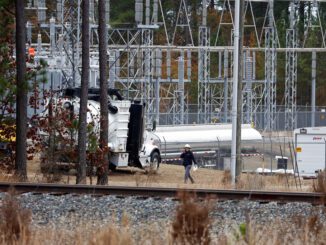
WASHINGTON, D.C. — Federal regulators ordered a review of security standards at the nation’s far-flung electricity transmission network, following multiple attacks shootings at electric substations in North Carolina and Washington state that damaged equipment and caused tens of thousands of customers to lose power.
The order by the Federal Energy Regulatory Commission directs officials to study the effectiveness of existing reliability standards for the physical security of the nation’s power grid and determine whether they need to be improved.
“The security and reliability of the nation’s electric grid is one of FERC’s top priorities,” FERC Chairman Richard Glick said at a recent commission meeting.
“In light of the increasing number of recent reports of physical attacks on our nation’s infrastructure, it is important that we fully and clearly review the effectiveness of our existing physical security standard to determine whether additional improvements are necessary to safeguard the bulk power system,” Glick said.
The order comes less than two weeks after one or more people drove up to two substations in central North Carolina, breached the gates and opened fire on them. Outages began shortly after the Dec. 3 nighttime attack and lasted several days before powers was restored to almost all households in Moore County four days later.
Even as power was restored, Duke Energy Corp., which owns the two North Carolina substations, reported gunfire Dec. 7 near another Duke facility in South Carolina. Law enforcement officials say they have found no evidence linking incidents in the two states, although multiple state and federal agencies continue to investigate.
At least four electrical substations have been targeted in separate attacks in Oregon and Washington state since November, most recently a fourth electrical substation was vandalized late on Christmas Day in Washington state.
The suspects broke into a fenced area and vandalized equipment, causing a fire, officials said. The fire was extinguished and power was later restored, but no suspects are in custody, officials said.
Grid security experts have said the attacks demonstrate anew the vulnerability of the nation’s electric grid, which includes more than 50,000 substations and more than 700,000 miles of transmission lines.
Power transformers are highly visible in thousands of sites across the country and “are really vulnerable — sometimes to a drunk with a gun and an attitude,” said FERC commissioner Mark Christie. “We have a lot of incidents of that. That’s not unusual. The substations are a different ballgame.”
He called the North Carolina attack “sophisticated” and noted that it caused outages for more than 40,000 people.
While officials are likely to recommend changes such as high-definition cameras, 24-hour surveillance or opaque walls, “How are we going to pay for all the upgrades?” asked Christie, a Republican who has served on the panel since 2020.
The bipartisan infrastructure law includes as much as $15 billion for power grid upgrades and resilience, and Christie said he hopes some of the money is used for “deferring some of the cost of the hardening that we know is going to take place” as a result of the recent attacks.
“I hope this does not flow through to ratepayers,” he said.
Glick, a Democrat, told reporters after the meeting that while he is always concerned about costs: “How concerned are you about the cost when the power goes out? Would you rather pay now or later?”
FERC approved a physical security reliability standard in 2014 following a still-unsolved attack on a major substation in California. The new order gives the North American Electric Reliability Corporation 120 days to submit a report on the current standard and recommend possible changes.

